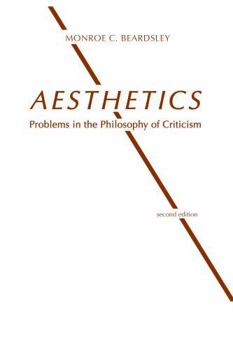Aesthetics: Problems in the Philosophy of Criticism
Select Format
Select Condition 
Book Overview
This second edition features a new 48-page Afterword--1980 updating Professor Beardsley's classic work.
Format:Paperback
Language:English
ISBN:0915145081
ISBN13:9780915145089
Release Date:March 1981
Publisher:Hackett Publishing Company
Length:688 Pages
Weight:2.02 lbs.
Dimensions:1.6" x 6.0" x 9.0"
Customer Reviews
2 ratings
Understand the Intentional Fallacy notion of textual interpretation
Published by Thriftbooks.com User , 16 years ago
I read this book for a graduate seminar on the philosophy of art. In Monroe C. Beardsley's "Aesthetics: Problems in Philosophy," he takes a "shot across the bow" of the neo-Romantic artworld's belief that an artwork reflects what the artist means or intends it to mean. Beardsley's argument is that artistic intention is irrelevant when it comes to the interpretation of an artist's work. At the time, this was a groundbreaking theory that seemed to give critical support to the new Abstract Expressionist works created by such pioneer artists as Jackson Pollock. However, most of Beardsley's "intentional fallacy" argument takes aim at the written word of poetry and literature. He argues, "That literary works are self-sufficient entities, whose properties are decisive in checking interpretations and judgments. This is sometimes called the Principle of Autonomy, and it is of course the subject of much dispute." It is in the artform of literature, that their theory has created the biggest stir and much "push back" to their notion, by accusing them of metaphorically "murdering the author" by arguing that once a work is written, an artist's intentions no longer have any bearing on the work. Beardsley's intentional fallacy notion created quite a stir within the artworld when he opened his argument with the statement, "That the design or intention of the author is neither available nor desirable as a standard for judging the success of a work of literary art, and it seems to us that this is a principle which goes deep into some differences in the history of critical attitudes." The "deep differences" of critical attitudes that Beardsley speaks about points directly to the artform of literature, which since the nineteenth century, was dominated by the neo-Romantic adherents of the "expression" theory. It is important to understand what Beardsley is essentially arguing against in their intentional fallacy theory, which is what is at the very core of the expression theory. A basic tenant of the expression theory is the idea when engaging an artwork, that it is important one needs to recognize the power of the artwork's ability in being able to focus on the mind of both the creator and the audience. Thus, expression theorists expect artworks will produce certain human emotions in the audience. The expression theory correctly recognizes that art, especially literature, possesses a certain power in being able to articulate the communicative and educative power of the mind and emotions of the artist to the audience. Beardsley supported his argument with several axioms. Their first one was that, "A poem does not come into existence by accident." However, although he agrees that the cause of the poem is through the mind of an author, he does not believe that the author's design or intention should be used as a standard to judge the poem's ultimate worth as successful literature. Therefore, unlike the expression theory, only the artwork matters. T
Theories of aesthetics- scholarship on the understanding and appreciation of art
Published by Thriftbooks.com User , 19 years ago
I know the first edition of this book. In that edition Beardsley maintains he wanted to show the independent value of the aesthetic realm and therefore worked in that direction. In the present revised edition he also tries to bring essays which connects artistic work with other realms of human activity. Anyone who has interest in the Theory of Art should have this volume in their library. And this because it does give a good sampling of the best scholarship on the subject. Beardsley in the new preface to the work talks about a problem he more or less skimmed over in the first edition, ' defining art' . He cites one essay that of M. Weitz who uses Wittgenstein's family resemblance concept to say that it is mistaken to define Art as one set of concepts only when there are ' overlapping concepts' between different realms. But of course making a definition of Art is only one problem of Aesthetics. ( Some by the way might answer in the famous Louie Armstrong style when asked to give a definition of 'jazz' Satchmo said ' If you got to ask, you don't know what it is' . This reminds me in a way of certain definitions of literature such as Kafka's an' axe to break up the frozen- sea within' . But of course the question of intuitive and instinctive reaction as opposed to more reflective response is one of the questions considered in this very rich and valuable volume.





